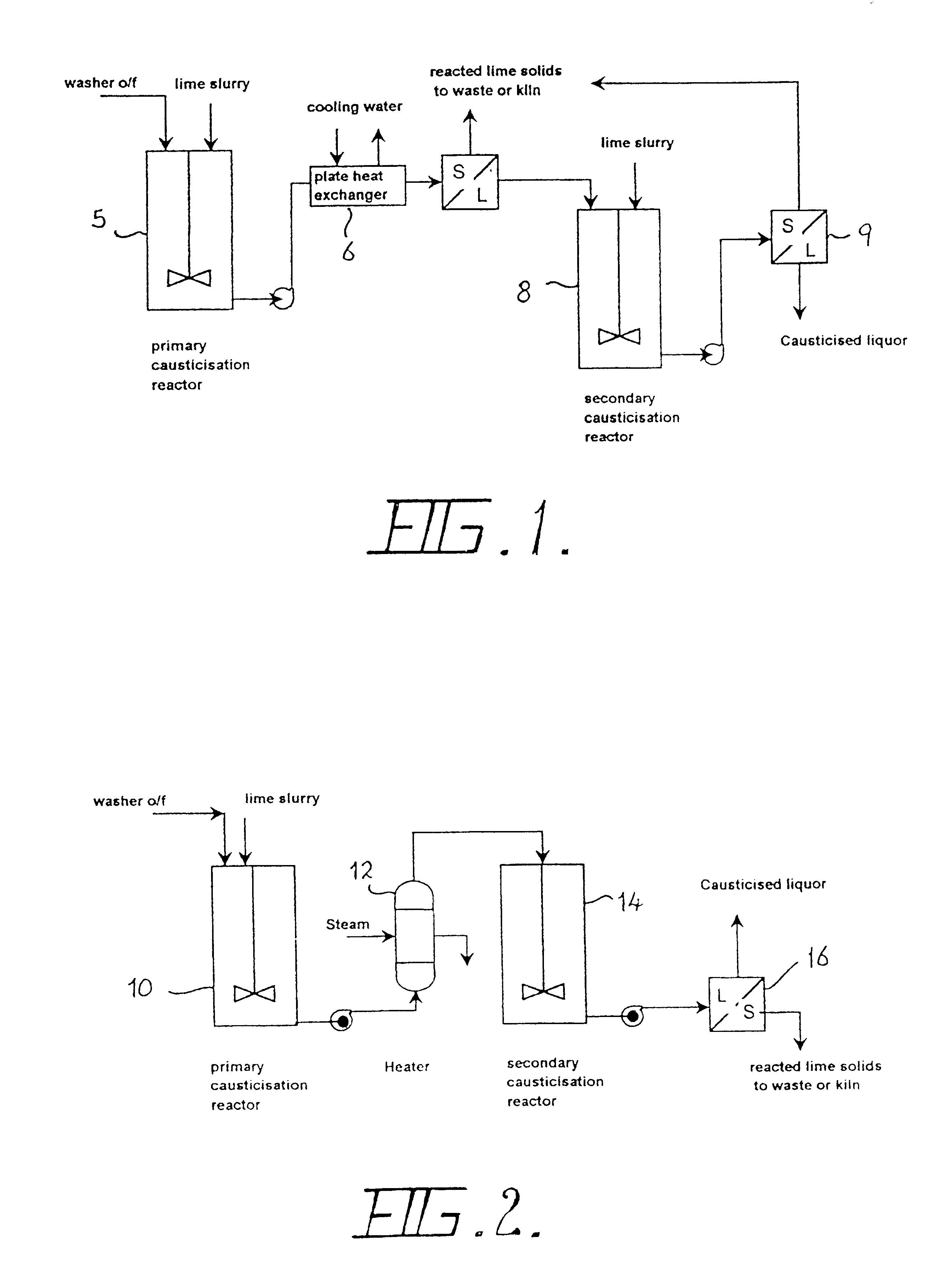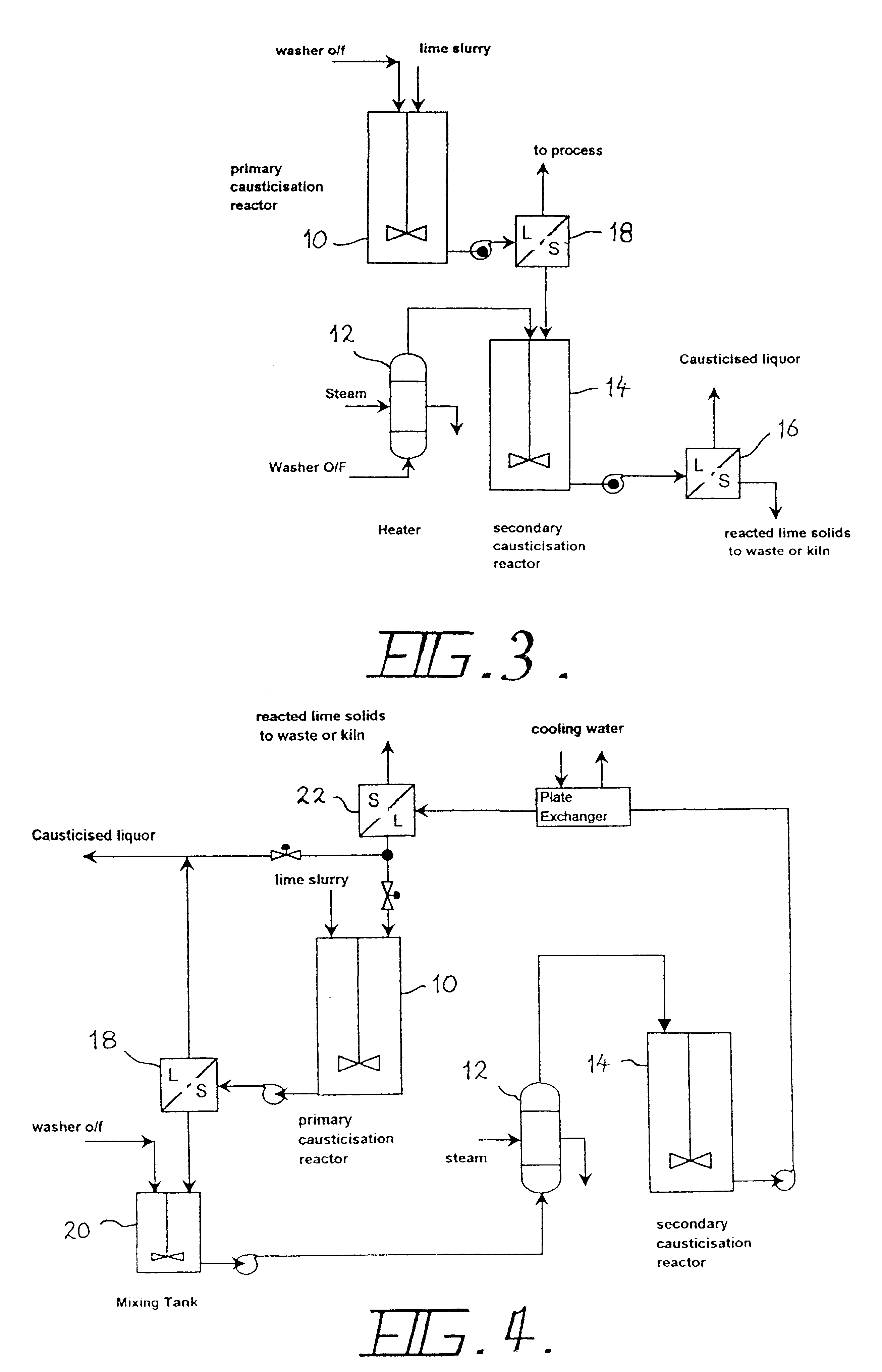Processes for the causticisation of Bayer liquors in an alumina refinery
a technology of alumina refinery and causticisation process, which is applied in the direction of magnesium compounds, aluminium compounds, transportation and packaging, etc., can solve the problems of reducing the productivity of the liquor, poor efficiency, and difficult to achieve c/s ratios higher than these, so as to improve the efficiency of lime utilisation, reduce the undesirable reaction of hydrocalumite to form tca, and increase the maximum c/s value
- Summary
- Abstract
- Description
- Claims
- Application Information
AI Technical Summary
Benefits of technology
Problems solved by technology
Method used
Image
Examples
example 2
A typical implementation of the improved causticisation process based on the first two of the preceding principles is shown in FIG. 2. In this system, a lime source (preferably a paste or slurry of slaked lime, although quicklime can be used) is fed together with the liquor to be causticised into a primary reactor vessel 10. Primary reactor 10 may be an in-line mixer, tubular reactor or stirred tank. Agitation conditions within this reactor 10 are not critical, although the reactors contents should be completely suspended. In this system, the vessel 10 is typically a stirred tank reactor and the liquor to be causticised will typically be a first or second washer overflow, as indicated in FIG. 1, although the process is in no way restricted to these. The applicable range of `S` concentration should be in the range of 40 to 250 g / L, although best performance is obtained for `S` concentrations between 80 and 160 gL. Improved performance is obtained for liquors with high A / C ratios. The...
example 3
Improved performance can be obtained by applying the third design principle--forming the hydrocalumite in another liquor, separating the solid product and liquor in a solid / liquid separation device 18, and using the hydrocalumite cake as the causticising agent in a secondary tank 14 fed with a suitable liquor stream. A simple conceptual flows diagram depicting this process is shown in FIG. 3. Similar plant components as in FIG. 2 are identified with the same reference numerals.
In this configuration, the A / C ratio of the liquor feeding the secondary causticiser 14 is maintained at a high level. This is aided by the reaction of Hc1 according to equation (7).
The high A / C ratio alters the equilibria in the secondary causticiser 14, permitting higher C / S ratios to be achieved. Of course, more lime is required to achieve these higher C / S ratios, but the lime efficiency is high, with low alumina losses. Some causticisation also occurs in the Primary Causticiser 10, contributing to the carb...
example 4
A substantial improvement over the basic implementations described above is shown in FIG. 4. In this embodiment, all four of the design principles have been incorporated. Lime is fed into a reaction vessel 10 (primary causticisation tank) operating at between 40 and 100.degree. C., more preferably 70 to 80.degree. C., together with a proportion of the causticised stream from the secondary causticisation tank 14. By doing this, a stream with an enhanced A / C and low carbonate concentration is fed into the primary reactor 10. The lime reacts with the aluminate ion to form the hydrocalumite species, and further causticises the liquor according to the reaction scheme described by equation (4) [and in some instances, possibly equation (5)]. The product thus formed is a pure hydrocalumite species containing a variable amount of carbonate, the extent depending upon the initial carbonate concentration of the liquor and the amount of lime added.
Under the conditions described above, the amount...
PUM
| Property | Measurement | Unit |
|---|---|---|
| concentration | aaaaa | aaaaa |
| concentration | aaaaa | aaaaa |
| concentration | aaaaa | aaaaa |
Abstract
Description
Claims
Application Information
 Login to View More
Login to View More - R&D
- Intellectual Property
- Life Sciences
- Materials
- Tech Scout
- Unparalleled Data Quality
- Higher Quality Content
- 60% Fewer Hallucinations
Browse by: Latest US Patents, China's latest patents, Technical Efficacy Thesaurus, Application Domain, Technology Topic, Popular Technical Reports.
© 2025 PatSnap. All rights reserved.Legal|Privacy policy|Modern Slavery Act Transparency Statement|Sitemap|About US| Contact US: help@patsnap.com



